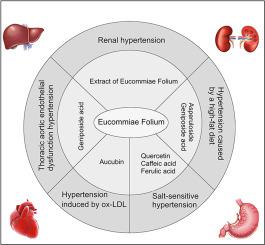Journal of Pharmaceutical Analysis ( IF 8.8 ) Pub Date : 2021-10-22 , DOI: 10.1016/j.jpha.2021.10.004 Mengyuan Li 1 , Yanchao Zheng 1 , Sha Deng 1 , Tian Yu 2 , Yucong Ma 3 , Jiaming Ge 1 , Jiarong Li 1 , Xiankuan Li 1 , Lin Ma 1

|
Eucommiae Folium (EF), a traditional Chinese medicine, has been used to treat secondary hypertension, including renal hypertension and salt-sensitive hypertension, as well as hypertension caused by thoracic aortic endothelial dysfunction, a high-fat diet, and oxidized low-density lipoprotein. The antihypertensive components of EF are divided into four categories: flavonoids, iridoids, lignans, and phenylpropanoids, such as chlorogenic acid, geniposide acid and pinoresinol diglucoside. EF regulates the occurrence and development of hypertension by regulating biological processes, such as inhibiting inflammation, regulating the nitric oxide synthase pathway, reducing oxidative stress levels, regulating endothelial vasoactive factors, and lowering blood pressure. However, its molecular antihypertensive mechanisms are still unclear and require further investigation. In this review, by consulting the relevant literature on the antihypertensive effects of EF and using network pharmacology, we summarized the active ingredients and pharmacological mechanisms of EF in the treatment of hypertension to clarify how EF is associated with secondary hypertension, the related components, and underlying mechanisms. The results of the network pharmacology analysis indicated that EF treats hypertension through a multi-component, multi-target and multi-pathway mechanism. In particular, we discussed the role of EF targets in the treatment of hypertension, including epithelial sodium channel, heat shock protein70, rho-associated protein kinase 1, catalase, and superoxide dismutase. The relevant signal transduction pathways, the ras homolog family member A (RhoA)/Rho-associated protein kinase (ROCK) and nicotinamide adenine dinucleotide phosphate (NADPH) oxidase/eNOS/NO/Ca2+ pathways, are also discussed.
中文翻译:

杜仲叶对继发性高血压的潜在治疗作用及应用
杜仲叶(EF)是一种中药,已被用于治疗继发性高血压,包括肾性高血压和盐敏感性高血压,以及胸主动脉内皮功能障碍、高脂饮食、氧化低密度引起的高血压。脂蛋白。EF的降压成分分为四类:黄酮类、环烯醚萜类、木脂素类和苯丙烷类,如绿原酸、栀子苷酸和松脂醇二糖苷。EF通过调节抑制炎症、调节一氧化氮合酶途径、降低氧化应激水平、调节内皮血管活性因子、降低血压等生物学过程来调节高血压的发生和发展。然而,其分子降压机制尚不清楚,需要进一步研究。本文通过查阅 EF 降压作用的相关文献,利用网络药理学,总结 EF 治疗高血压的活性成分和药理机制,阐明 EF 与继发性高血压的关系、相关成分以及底层机制。网络药理学分析结果表明,EF通过多组分、多靶点、多通路机制治疗高血压。特别是,我们讨论了 EF 靶点在治疗高血压中的作用,包括上皮钠通道、热休克蛋白 70、rho 相关蛋白激酶 1、过氧化氢酶和超氧化物歧化酶。相关的信号转导途径,2+途径,也进行了讨论。



























 京公网安备 11010802027423号
京公网安备 11010802027423号